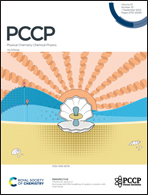Mechanism of formation of Co–Ru nanoalloys: the key role of Ru in the reduction pathway of Co†
Abstract
The chemical synthesis of alloy nanoparticles requires adequate conditions to enable co-reduction instead of separate reduction of the two metal cations. The mechanism of formation of bimetallic cobalt–ruthenium nanoalloys by reducing metal salts in an alcohol medium was explored to draw general rules to extrapolate to other systems. The relative kinetics of the reduction of both metal cations were studied by UV-visible and in situ Quick-X-ray absorption spectroscopies as well as H2 evolution. The addition of Co(II) ions does not influence the reduction kinetics of Ru(III) but adding Ru(III) to a Co(II) solution promotes the reduction of cobalt cations. Indeed, while CoO is formed when reaching the boiling temperature of the solvent for the monometallic system, a direct reduction of Co is observed at this temperature without formation of the oxide for the bimetallic one. The co-reduction of the metal cations results in the formation of bimetallic nanoplatelets, the size of which can be tuned by changing the Ru content.



 Please wait while we load your content...
Please wait while we load your content...